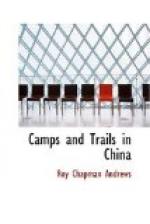Our second camp was on the river at the mouth of a deep valley, near a small village. Wu said that the natives were Lutzus and I was inclined to believe he was right, although Major Davies indicates this region to be inhabited by Lisos. At any rate these people both in physical appearance and dress were quite distinct from the Lisos whom we met later.
They were exceedingly pleasant and friendly and the chief, accompanied by four venerable men, brought a present of rice. I gave him two tins of cigarettes and the natives returned to the village wreathed in smiles.
The garments of the Lutzus were characteristic and quite unlike those of the Mosos, Lisos or Tibetans. The women wore a long coat or jacket of blue cloth, trousers, and a very full pleated skirt. The men were dressed in plum colored coats and trousers.
The natives said that monkeys (probably Pygathrix) were often seen when the corn was ripe and that even yet they might be found in the forest across the river. Heller spent a day hunting them, but found none and we obtained only one new mammal in our traps. It was a tiny mouse (Micromys) but the remainder of the fauna was essentially the same as that of the Yangtze valley and the intervening country.
For three days we traveled down the Mekong River. Although the natives said that the trail was good, we discovered when it was too late that it was too narrow and difficult to make it practicable for a caravan such as ours. It was necessary to continually remove the loads in order to lift them around sharp corners or over rocks, and the mafus sometimes had to cut away great sections of the bank. Usually only six or seven miles could be traversed after eight or nine hours of exhausting work, and we were glad when we could leave the river.
The Mekong, on an average, is not more than a hundred yards wide in this region and, like the Yangtze, the water is very green from the Tibetan snows. The prevailing rock is red slate or sandstone instead of limestone, as in the country to the eastward, and the sides of the valley are so precipitous that it seems impossible for a human being to walk over them, and yet they are patched with brown corn fields from the summit to the water. Considering the small area available for cultivation there are a considerable number of inhabitants, who have gathered into villages and seldom live in isolated houses as in the Yangtze valley. Wherever a stream comes down from the mountain-side or can be diverted by irrigating ditches, the ground is beautifully terraced for rice paddys, but in other places, corn and peas appear to be the principal crops. Very few vegetables, such as turnips, squash, carrots or potatoes are raised, which is rather remarkable, as they are so abundant in all the country between the Mekong and the Yangtze rivers. In several places the water was spanned by rope bridges. The cables are made of twisted bamboo, and as one end must necessarily be higher than the other, there are always two ropes, one to cross each way. The traveler is tied by leather thongs in a sitting position to a wooden “runner” which slides along the bamboo cable and shoots across the river at tremendous speed.




